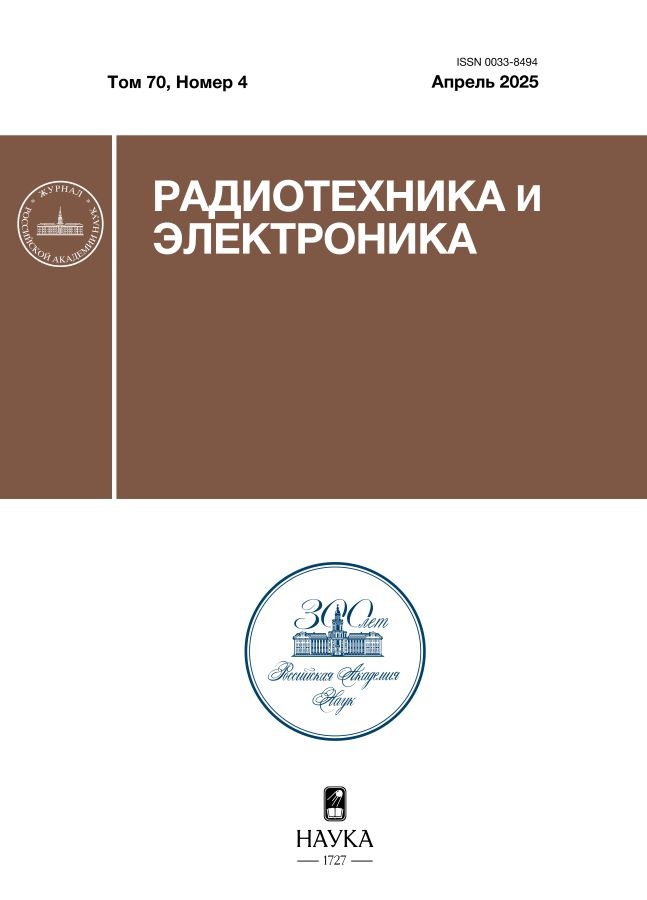Detection of microwave radiation by a ferromagnetic/normal metal heterostructure in the near field of an antenna
- Autores: Volkov D.A.1,2, Matveev A.A.1,3, Gabrielyan D.A.1,2, Safin A.R.1,2, Mikhailov M.S.1,2, Nikitov S.A.1,3,4
-
Afiliações:
- Kotelnikov Institute of Radio Engineering and Electronics, Russian Academy of Sciences
- National Research University “Moscow Power Engineering Institute” (MPEI)
- Moscow Institute of Physics and Technology (National Research University)
- Saratov National Research State University named after N.G. Chernyshevsky
- Edição: Volume 70, Nº 4 (2025)
- Páginas: 370-375
- Seção: TO THE 70th ANNIVERSARY OF S.A. NIKITOV
- URL: https://ter-arkhiv.ru/0033-8494/article/view/687498
- DOI: https://doi.org/10.31857/S0033849425040064
- EDN: https://elibrary.ru/FSNTGK
- ID: 687498
Citar
Texto integral
Resumo
The operation of a spintronic detector in the near field of an antenna emitting a microwave signal at a frequency of 10 GHz has been investigated. The feasibility of using a detector based on a Lu₃Fe₅O₁₂/Pt heterostructure, operating due to the inverse spin Hall effect, has been studied. A comparison was made between the experimentally measured output voltage of the detector and theoretical calculations of the power distribution of the electromagnetic field, performed using COMSOL Multiphysics. The sensitivity of the detector was determined, and the dependence of the output signal on the distance to the radiation source was measured. The obtained results confirm the feasibility of using spintronic heterostructures in wireless data and energy transmission systems. The prospects for using the detector in wireless communication and data transmission systems operating in the near field of an antenna, such as RFID (Radio Frequency Identification) and NFC (Near Field Communication), are considered.
Palavras-chave
Texto integral
Sobre autores
D. Volkov
Kotelnikov Institute of Radio Engineering and Electronics, Russian Academy of Sciences; National Research University “Moscow Power Engineering Institute” (MPEI)
Autor responsável pela correspondência
Email: d.a.volkov.work@gmail.com
Rússia, Mokhovaya Str., 11, Build. 7, Moscow, 125009; Krasnokazarmennaya Str., 14, build. 1, Moscow, 111250
A. Matveev
Kotelnikov Institute of Radio Engineering and Electronics, Russian Academy of Sciences; Moscow Institute of Physics and Technology (National Research University)
Email: d.a.volkov.work@gmail.com
Rússia, Mokhovaya Str., 11, Build. 7, Moscow, 125009; Institutskiy per., 9, Dolgoprudny, Moscow Region, 141700
D. Gabrielyan
Kotelnikov Institute of Radio Engineering and Electronics, Russian Academy of Sciences; National Research University “Moscow Power Engineering Institute” (MPEI)
Email: d.a.volkov.work@gmail.com
Rússia, Mokhovaya Str., 11, Build. 7, Moscow, 125009; Krasnokazarmennaya Str., 14, build. 1, Moscow, 111250
A. Safin
Kotelnikov Institute of Radio Engineering and Electronics, Russian Academy of Sciences; National Research University “Moscow Power Engineering Institute” (MPEI)
Email: d.a.volkov.work@gmail.com
Rússia, Mokhovaya Str., 11, Build. 7, Moscow, 125009; Krasnokazarmennaya Str., 14, build. 1, Moscow, 111250
M. Mikhailov
Kotelnikov Institute of Radio Engineering and Electronics, Russian Academy of Sciences; National Research University “Moscow Power Engineering Institute” (MPEI)
Email: d.a.volkov.work@gmail.com
Rússia, Mokhovaya Str., 11, Build. 7, Moscow, 125009; Krasnokazarmennaya Str., 14, build. 1, Moscow, 111250
S. Nikitov
Kotelnikov Institute of Radio Engineering and Electronics, Russian Academy of Sciences; Moscow Institute of Physics and Technology (National Research University); Saratov National Research State University named after N.G. Chernyshevsky
Email: d.a.volkov.work@gmail.com
Rússia, Mokhovaya Str., 11, Build. 7, Moscow, 125009; Institutskiy per., 9, Dolgoprudny, Moscow Region, 141700; Astrakhanskaya Str., 83, Saratov, 410012
Bibliografia
- Locatelli N., Cros V., Grollier J. // Nature Mater. 2014. V. 13. № 1. P. 11.
- Shao Q., Li P., Liu L. et al. // IEEE Trans. 2021. V. MAG-57. № 7. Article No. 800439.
- Hикитов С.А., Сафин А.Р., Калябин Д.В. и др. // Успехи физ. наук. 2020. Т. 190. № 10. С. 1009.
- Puebla J., Kim J., Kondou K., Otani Y. // Commun. Mater. 2020. V. 1. № 1. Article № 24.
- Hemour S. Zhao Y., Lorenz C.H.P. et al. // IEEE Trans. 2014. V. MAG-62. № 4. P. 965.
- Liu L., Li Y., Liu Y. et al. // Phys. Rev. B. 2020. V. 102. № 1. P. 014411.
- Sharma V., Saha J., Patnaik S., Kuanr B.K. // J. Magn. Magn. Mater. 2017. V. 439. P. 277.
- Jermain C.L., Paik H., Aradhya S.V. et al. // Appl. Phys. Lett. 2016. V. 109. № 19. P. 192408.
- Akhtar M.N., Yousaf M., Khan S.N. et al. // Ceramics Int. 2017. V. 43. № 18. P. 17032.
- Волков Д.А., Габриелян Д.А., Матвеев А.А. и др. // Письма в ЖЭТФ. 2024. Т. 119. № 5. С. 348.
- Tserkovnyak Y., Brataas A., Bauer G.E. // Phys. Rev. Lett. 2002. V. 88. № 11. P. 117601.
- Tserkovnyak Y., Ochoa H. // Phys. Rev. B. 2017. V. 96. № 10. P. 100402.
- Zhu L., Ralph D.C., Buhrman R.A. // Phys. Rev. Lett. 2019. V. 123. № 5. P. 057203.
- Hикулин Ю.В., Хивинцев Ю.В., Селезнев М.Е. и др. // Письма в ЖЭТФ. 2024. Т. 119. № 9. С. 676.
Arquivos suplementares














